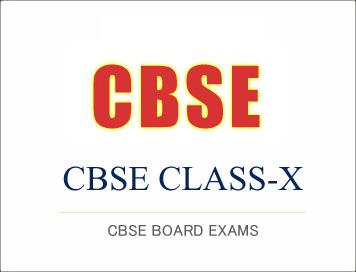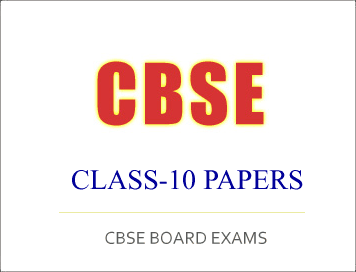
(Download) CBSE Class-10 2016-17 Sample Paper (Spanish)
-
Please check that this question paper contains 04 printed pages.
-
Code number given on the question paper should be written on the title page of the answer-book by the candidate.
-
Please check that this question paper contains 12 questions. Answer all questions in the target language.
-
Please write down the serial number of the question before attempting it
Time allowed: 03 hrs. Maximum Marks: 90
1. Lee el siguiente texto sobre el pintor colombiano Fernando Botero y señala si es verdadero (V) o falso (F). Read the following text about the Colombian painter, Fernando Botero, and reply TRUE/FALSE 05 Pocos artistas hispanoamericanos han logrado tanta repercusión a nivel internacional como el pintor y escultor colombiano Fernando Botero. Nacido en Medellín en 1932, Fernando Botero fue el segundo de los tres hijos de la pareja formada por David Botero Mejía y Flora Angulo de Botero
Aunque en su juventud estuvo durante un corto lapso de tiempo en la Academia de San Fernando en Madrid y en la de San Marcos en Florencia, su formación artística fue autodidacta. Sus primeras obras conocidas son las ilustraciones que publicó en el suplemento literario del diario El Colombiano, de su ciudad natal. A los 19 años viajó a Bogotá, donde hizo su primera exposición individual. Posteriormente viajó a Europa, donde residió por espacio de cuatro años, principalmente en Madrid, Barcelona, París y Florencia.
Aunque ingresó en las academias mencionadas, siguió formándose a base de leer, visitar museos y, sobre todo, pintar, como él mismo diría. Luego viajó a México, Nueva York y Washington en un período de febril creación y escasos recursos económicos, acompañado de su esposa Gloria Zea. Entre 1961 y 1973 fijó su residencia en Nueva York. Luego viviría en París, alternando su residencia en la capital francesa con largas estancias en Pietrasanta o su finca en el pueblo cundinamarqués de Tabio. En 1977 expuso sus bronces por primera vez en el Grand Palais de París. Tras cuatro decenios de labor ininterrumpida, su reconocimiento en el campo escultórico se hizo también universal. Convertido ya en uno de los artistas vivos más cotizados del mundo, Botero no ha dejado nunca, sin embargo, de alzar la voz contra la injusticia y de mantener su arte en línea con la realidad histórica y social.
a) Fernando Botero es un pintor hispanoamericano. V/F
b) Publicó sus primeras ilustraciones en un suplemento literario publicado en Medellín. V/F
c) Hizo su primera exposición individual en el año 1951. V/F
d) En el texto se afirma que Botero es un artista autodidacta. V/F
e) Según el texto, el artista actualmente vive en Nueva York. V/F
2. Lee el texto y contesta verdadero (V) o falso (F). Read the following text and reply TRUE/FALSE. En estos tiempos, todos estamos de acuerdo en que hacer ejercicios es bueno para nuestra salud, pero a veces no aprovechamos todas sus ventajas al no hacerlo de manera correcta. Hay algunas normas para sacarle el máximo partido al ejercicio. En primer lugar, algunas personas piensan que deben seguir siempre una misma tabla de gimnasia, sin embargo, los músculos del cuerpo, después de unos meses de actividad, tienden a habituarse, haciendo que los ejercicios sean cada vez menos eficaces. Por eso conviene ir variando poco a poco la tabla de ejercicios.
Además de esto, es necesario cambiar esa imagen de una persona que suda y resopla mientras hace ejercicio. Es cierto que se necesita alcanzar un cierto ritmo que acelere la frecuencia de respiración, pero la intensidad debe ser la justa para que nos permita hablar a la vez que corremos, andamos, vamos en bicicleta, etc…Por otra parte, en cuanto a los ejercicios de suelo o con pesas, lo mejor es realizarlos despacio y con calma y prestar mucha atención al momento de volver a la posición inicial.
Es caso de que se realicen deportes asimétricos, como el tenis, es muy recomendable que, después del entrenamiento, hagamos otros ejercicios compensatorios, ya que en el tenis por ejemplo, se utilizan más los músculos de un lado que los del otro. Por último, lo que nunca debemos olvidad es que después de nuestra sesión de ejercicio, hay que hacer a menos 5 minutos de estiramientos. Estos sirven para evitar lesiones y molestias. (Adaptado de Revista Consumer)
a) Según el texto, no se debe cambiar la tabla de ejercicios cuando queremos desarrollar más los músculos. V/F
b) En el texto se recomienda que al correr, aceleramos la respiración. V/F
c) En el texto se afirma que los estiramientos actúan como ejercicios compensatorios en actividades asimétricas.
d) ¿Estás de acuerdo con el mensaje del texto? Sí/No, y ¿por qué? (Do you subscribe to the idea contained in the text? Yes/No, and Why?)
3. Lee el siguiente diálogo y contesta a las siguientes preguntas. Read the following dialogue and answer the following questions. 05
Pedro fue a la librería y compró La Eda de Oro, de José Martí. Cuando llegó al albergue, puso el libro sobre la mesa. Poco después entró Antonio y preguntó:
- ¿De quién es este libro?
- Es mío – le contestó Pedro-, y tuyo también – añadió.
- Gracias, Pedro. Entonces, como es nuestro, voy a leerlo otra vez. Me gusta muchísimo esta obra que Martí escribió para los niños de América.
- A mí también. Quiero leerla otra vez, porque siempre aprendo algo nuevo cuando releo cualquiera de sus obras.
-¿Tienes algún otro libro suyo? –le preguntó Pedro a su amigo Antonio.
- Sí, allí en aquel librero están sus Versos sencillos.
- ¡Qué bueno! ¿Me lo prestas para mi amigo Jesús? Él quiere aprender algunos de esos versos para cantarlos con la música de La Guantanamera.
- Sí, puedes cogerlo.
a) ¿Qué compró Pedro?
b) ¿Qué le preguntó Antonio cuando entró?
c) ¿Qué le contestó Antonio?
d) ¿Antonio ya leyó La Edad de Oro?
e) ¿Para quiénes Martí escribió esa obra?


